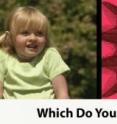Visual pattern preference may be indicator of autism in toddlers
Using eye-tracking methods, researchers at the University of California, San Diego School of Medicine have shown that toddlers with autism spend significantly more time visually examining dynamic geometric patterns than they do looking at social images – a viewing pattern not found in either typical or developmentally delayed toddlers. The results of the study suggest that a preference for geometric patterns early in life may be a signature behavior in infants who are at-risk for autism. This preference was found in infants at-risk for autism as young as 14 months of age. “In testing 110 toddlers ages 14 to 42 months, we found that all of the toddlers who spent more than 69 percent of their time fixing their gaze on geometric images could be accurately classified as having an autism spectrum disorder or ASD,” said Karen Pierce, PhD, an assistant professor in the UCSD Department of Neurosciences and assistant director of the UCSD Autism Center of Excellence. The study will be published in the September 6 issue of the Archives of General Psychiatry.
During this study, babies ranging in age between 12 and 42 months sat on their mother’s lap as they watched a one-minute movie that contained shapes moving on one side of the screen (i.e., “dynamic geometric patterns) and children dancing and doing yoga on the other (i.e., “dynamic social images”). Using an infrared light beam that bounces off the eye, Pierce and colleagues were able to measure what the baby liked to look at by measuring the amount of time they examined each side of the screen. Interestingly, the dynamic geometric patterns that absorbed the attention of autistic but not normal babies, was nothing more than a common screen saver found on most computers.
Out of 51 typical infants in this study, only one preferred to look at the geometric images. However, not all autistic toddlers preferred the geometric shapes. In the UCSD study, 40 percent of the ASD toddlers had this preference, compared to just two percent of the typical and nine percent of the developmentally delayed toddlers. Thus, while 40 percent of the ASD toddlers were “geometric responders,” the remaining 60 percent were similar to the typical and developmentally delayed groups in preferring dynamic social images.
“What an infant prefers to look at when given a choice between two images may turn out to be a more clearly observable indicator of autism risk than how he or she looks at a single image,” Pierce said. “Among toddlers who strongly prefer geometric patterns, we found that – almost 100 percent of the time – those children developed an autism spectrum disorder.”
A preference for geometric patterns alone may be an intriguing novel identifier of early autism, but the research results also illustrated a distinct pattern of saccades – rapid, directed eye movements – among the geometric responders.
“We initially predicted that ASD toddlers overall would show a reduced number of saccades,” Pierce explained However, results revealed that it was only the geometric responders, not the group as a whole, who displayed a reduced number of saccades; and this pattern was only evident when they were viewing their preferred geometric patterns. “It was almost as if they got ‘stuck’ and didn’t move their eyes as much as typical toddlers when viewing geometric patterns. The geometric patterns were apparently very absorbing to them.”
The researchers concluded that a preference for moving geometric patterns, combined with how long toddlers stare when looking at moving geometric images, might be an early identifier of autism.
“If your baby occasionally enjoys looking at the screen saver on your computer, it is no cause for alarm,” said Pierce. “But if your baby looks at such moving geometric patterns for long periods of time, but not at fun, social images, you might want to check for other early warning signs of autism.”
Such warning signs include reduced enjoyment during back-and-forth games like peek-a-boo; the presence of an unusual tone of voice; a lack of pointing at or bringing objects to show; and a failure to respond when his/her name is called.
“If your baby shows multiple such ‘red-flags,’ then speak to your pediatrician about a developmental evaluation,” Pierce advised.
Source: University of California - San Diego
Articles on the same topic
- Some children with autism show a preference for geometric patterns at an early ageMon, 6 Sep 2010, 21:07:49 UTC
Other sources
- Visual pattern preference may be indicator of autism in toddlersfrom Science DailyTue, 7 Sep 2010, 2:21:51 UTC
- Visual pattern preference may be indicator of autism in toddlersfrom Science BlogMon, 6 Sep 2010, 21:21:12 UTC
- Some children with autism show a preference for geometric patterns at an early agefrom Science BlogMon, 6 Sep 2010, 21:21:11 UTC
- Visual pattern preference may be indicator of autism in toddlersfrom PhysorgMon, 6 Sep 2010, 21:07:18 UTC
